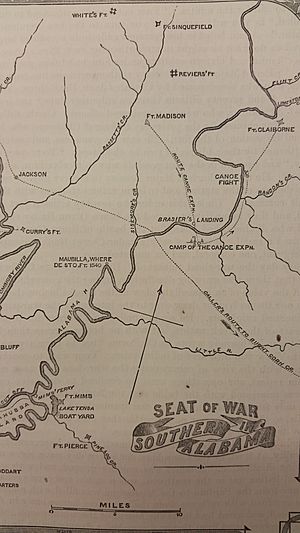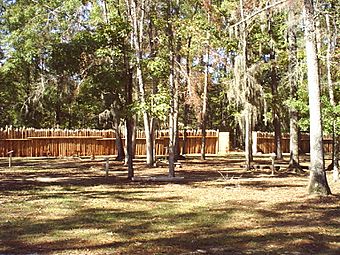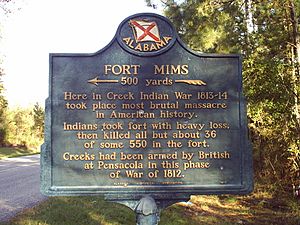Fort Mims massacre facts for kids
Quick facts for kids Fort Mims massacre |
|||||||
|---|---|---|---|---|---|---|---|
| Part of Creek War | |||||||
 |
|||||||
|
|||||||
| Belligerents | |||||||
| Red Stick Creek | |||||||
| Commanders and leaders | |||||||
|
Head warriors (Tastanagi): William Weatherford Peter McQueen |
Major Daniel Beasley Dixon Bailey |
||||||
| Strength | |||||||
| 750-1,000warriors |
265 militia, including:
|
||||||
| Casualties and losses | |||||||
| 50 to 100 killed unknown wounded |
265 militia killed or captured 252 civilians killed or captured unknown wounded Fort Mims severely damaged |
||||||
The Fort Mims massacre happened on August 30, 1813, during the Creek War. A group of Creek Indians called the Red Sticks attacked Fort Mims. Their leaders were Peter McQueen and William Weatherford, also known as Red Eagle.
The Red Sticks stormed the fort and defeated the soldiers defending it. After the battle, many people inside the fort were killed or captured. These included Creek people of mixed heritage, white settlers, and soldiers. Fort Mims was a stockade (a fence made of strong posts) with a blockhouse (a small fort) built around the home of Samuel Mims. It was located about 35 miles north of what is now Mobile, Alabama.
Contents
Why the Attack Happened

The Creek Nation was a large group of Native American tribes. They split into two main groups around the time of the War of 1812. One group, called the Red Sticks, did not want to give up their land to white settlers. They also did not want to adopt the European-American way of life. The other Creek group was more open to living like the white settlers.
The Red Sticks were named because they used a "red stick of war," which was a symbol of declaring war. In the summer of 1813, a civil war started among the Creeks. The Red Sticks attacked leaders who were friendly with the settlers. They also destroyed animals that belonged to Creeks who had adopted European customs.
White settlers on the frontier became worried. They did not understand the problems within the Creek Nation. Many settlers moved into forts and blockhouses, like Fort Mims, for safety. More soldiers were sent to protect the frontier.
The Battle of Burnt Corn
American spies found out that Peter McQueen and his Red Stick group were in Pensacola, Florida. They were getting food, supplies, and weapons from the Spanish governor. The Creek received corn, flour, blankets, and gunpowder.
When Colonel Caller heard about this, he and Major Daniel Beasley led a group of 150 white soldiers and 30 mixed-heritage Creek people. They wanted to stop the Red Sticks. In July 1813, James Caller's group ambushed the Red Sticks during their meal. This event was called the Battle of Burnt Corn. While the American forces were taking supplies, the Red Stick warriors returned and drove them away. After this, the United States was officially at war with the Red Stick Creek Nation.
In August 1813, Peter McQueen and Red Eagle (Weatherford) led nearly 1,000 Red Stick warriors. These warriors came from thirteen Creek towns. They gathered near the Alabama River, planning to attack Fort Mims.
About 517 people were inside Fort Mims. This included mixed-heritage Creeks who had moved there for safety, along with European-American settlers. There were also about 265 armed soldiers. The fort was located about 35 to 45 miles north of Mobile.
The Attack on Fort Mims
On August 29, 1813, two enslaved people who were tending cattle outside the fort reported seeing "painted warriors." However, scouts from the fort found no signs of the war party. Major Beasley, the commander, had the second enslaved person punished for giving a "false alarm." Beasley received another warning the next morning, but he ignored it and took no extra safety steps.
Major Beasley had said he could "maintain the post against any number of Indians." However, historians believe the fort was not well defended. When the attack happened, the east gate was partly open because sand had drifted against it. Beasley also did not place any guards or lookouts.
The Red Sticks attacked during the mid-day meal. They tried to take the fort quickly by rushing the open gate all at once. They also took control of the small openings used for shooting. Inside the fort, Captain Bailey led the soldiers and settlers who fought back. They held the inner part of the fort for about two hours.
The Red Sticks then paused for about an hour. They had lost some warriors and debated whether to continue fighting. By 3 o'clock, they decided they must kill the mixed-heritage Native Americans led by Dixon Bailey to get revenge for the Battle of Burnt Corn.
The Creeks launched a second attack at 3 p.m. The remaining defenders moved into a building called the 'bastion.' The Red Sticks set fire to this building, and the fire spread to the rest of the fort. The warriors forced their way inside. Despite attempts by Weatherford to stop them, they killed most of the soldiers, mixed-heritage Creeks, and white settlers.
After hours of fighting, the defense completely broke down. About 500 soldiers, settlers, enslaved people, and Creeks loyal to the Americans were killed or captured. By 5 p.m., the battle was over. The fort and its buildings were looted and burning. The Red Sticks spared most of the enslaved people, taking over 100 of them captive. At least three women and ten children were also taken captive. About 36 people, mostly men, managed to escape. This included Bailey, who was badly wounded.
Weeks later, a rescue group arrived from Fort Stoddard. They found 247 bodies of the defenders and 100 bodies of the Creek attackers. After their victory, the Red Sticks destroyed the farms around the fort. They killed over 5,000 cattle, burned crops and houses, and took or killed enslaved people.
What Happened Next
|
Fort Mims Site
|
|

Inside the reconstructed fort, looking at the west wall and gate.
|
|
| Lua error in Module:Location_map at line 420: attempt to index field 'wikibase' (a nil value). | |
| Nearest city | Tensaw, Alabama |
|---|---|
| Area | 5 acres (2.0 ha) |
| Built | 1813 |
| NRHP reference No. | 72000153 |
| Added to NRHP | September 14, 1972 |
The Red Sticks' victory at Fort Mims caused great fear across the Southern United States. Settlers demanded that the government take action and many fled their homes. In the weeks after the battle, thousands of people, about half the population of the nearby areas, ran to Mobile for safety.
This victory, one of the greatest ever achieved by Native Americans, changed the conflict. It turned from a civil war within the Creek tribe into a war between the United States and the Red Stick warriors.
Since federal troops were busy fighting in the northern part of the War of 1812, the states of Tennessee, Georgia, and the Mississippi Territory sent their own soldiers. These militias, led by Major General Andrew Jackson and joined by Cherokee allies, eventually defeated the Red Sticks. This happened at the Battle of Horseshoe Bend, which ended the Creek War.
Today, the Fort Mims site is looked after by the Alabama Historical Commission. It was added to the National Register of Historic Places on September 14, 1972.
The Fort Mims massacre is also mentioned in the famous novel Gone with the Wind. In the book, a character named Grandma Fontaine shares her memories of the Creek uprising that followed the massacre. She tells a story about her family being killed. She uses this story to teach the main character, Scarlett, that once you experience the worst, you can never truly be afraid again.
Images for kids
See also
 In Spanish: Masacre del Fuerte Mims para niños
In Spanish: Masacre del Fuerte Mims para niños




